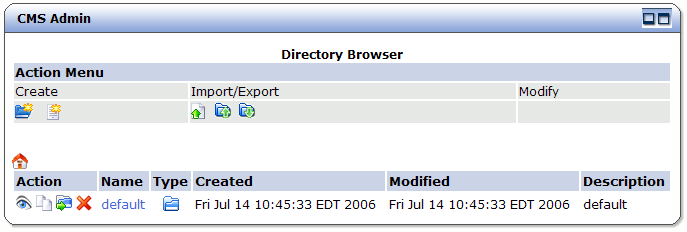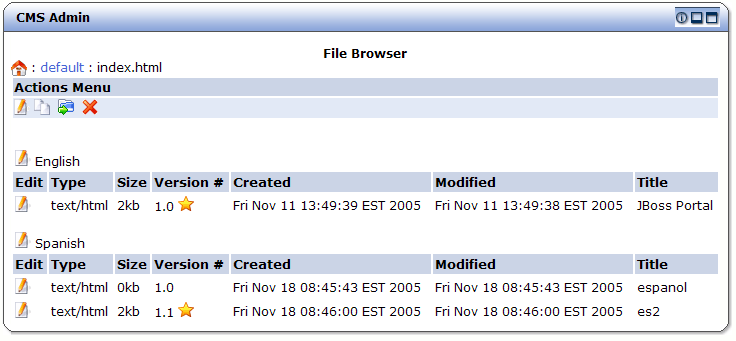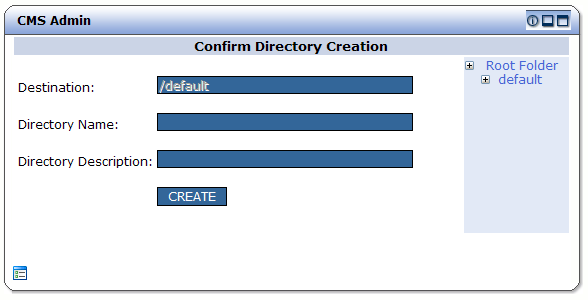Chapter 3. Administration - Content Management System - JBoss Portal 2.4 User Guide 英文版用户使用指南文档
The CMSAdmin Portlet allows control over the content management system.
Viewing the CMSAdmin Portlet is accomplished by logging in as an admin (admin/admin) and navigating to the Admin page.
You should then be presented with a page that is similar to this:
 |
It is important for a user to note the action icons used throughout the portlet and their meanings. The action options change depending on what type of resource the user is dealing with. All possible actions are listed here:
 - Launches HTML WYSIWYG Editor window for HTML files. Launches upload dialog
windoe for binary type files.
- Launches HTML WYSIWYG Editor window for HTML files. Launches upload dialog
windoe for binary type files.
 - Opens the copy file/folder dialog window.
- Opens the copy file/folder dialog window.
 - Opens the move file/folder dialog window.
- Opens the move file/folder dialog window.
 - Launches HTML WYSIWYG Editor window.
- Launches HTML WYSIWYG Editor window.
 - Opens the create folder dialog window.
- Opens the create folder dialog window.
 - Opens the upload file dialog window.
- Opens the upload file dialog window.
 - Opens the upload archive dialog window.
- Opens the upload archive dialog window.
 - Opens the export archive dialog window.
- Opens the export archive dialog window.
 - Opens the delete confirmation dialog window.
- Opens the delete confirmation dialog window.
 - In the case of files, opens the file properties view. In the case of
folders, opens the folder listing.
- In the case of files, opens the file properties view. In the case of
folders, opens the folder listing.
 - Moves up the folder tree when clicked on.
- Moves up the folder tree when clicked on.
 - Expands directory tree.
- Expands directory tree.
Additionally, there are icons that help describe the types of resources present on the page:
 - Denotes this resource as a file.
- Denotes this resource as a file.
 - Denotes this resource as a folder.
- Denotes this resource as a folder.
This section describes common actions an administrator can perform from within the AdminCMS Portlet:
 |
A user can list directory contents by either clicking on the
 icon, or clicking on the directory's "DisplayName". All actions are possible
from this screen.
icon, or clicking on the directory's "DisplayName". All actions are possible
from this screen.
 |
Clicking on the
 icon or the "DisplayName" of a file brings up the File Properties page.
icon or the "DisplayName" of a file brings up the File Properties page.
 |
The File Properties window displays all the possible actions available to perform on a file.
Version and Locale Information are also contained on this screen. Note that any version
labeled with the
 is the current "live" version shown to users.
is the current "live" version shown to users.
Clicking on the
 icon displays the copy file/directory dialog window.
icon displays the copy file/directory dialog window.
 |
The copy resource window allows a user to copy files to any folder on the system, as
well as copy whole directory trees to any directory on the system. A user can select which
destination directory to copy the resource to, by using the directory browser. Clicking the
 icon expands the directory tree. Clicking on the name of the directory within
the tree, sets it as the destination directory for the copied resource.
icon expands the directory tree. Clicking on the name of the directory within
the tree, sets it as the destination directory for the copied resource.
Clicking on the
 icon displays the move file/directory dialog window.
icon displays the move file/directory dialog window.
 |
The move resource window allows a user to move files to any folder on the system, as
well as move whole directory trees to any directory on the system. A user can select which
destination directory to move the resource to, by using the directory browser. Clicking the
 icon expands the directory tree. Clicking on the name of the directory within
the tree, sets it as the destination directory for the moved resource.
icon expands the directory tree. Clicking on the name of the directory within
the tree, sets it as the destination directory for the moved resource.
Clicking on the
 icon displays the delete file/directory confirmation window.
icon displays the delete file/directory confirmation window.
 |
The delete resource confirmation window allows a user to delete a file, or a directory on the system. Note that deleting a directory, will delete the entire tree, so all directories under the deleted one, will also be deleted.
Warning
Currently, there is no way to retrieve deleted files/directories! Deleting a file or directory is permanent!Clicking on the
 icon displays the create directory dialog window.
icon displays the create directory dialog window.
 |
The create directory resource window allows a user to create a directory under chosen path. On this window, a user can specify a name for the new empty directory and assign it a description.
Clicking on the
 icon displays the create file dialog window with the embedded WYSIWYG editor
and directory browser.
icon displays the create file dialog window with the embedded WYSIWYG editor
and directory browser.
 |
The create file window allows a user to create a text or HTML file using the embedded
WYSIWYG HTML editor. The editor is a fully-functional HTML editor with a myriad of HTML
functions. It also includes a preview
 button and a source view
button and a source view
 button.
button.
An in-depth walk-through of the editor is beyond the scope of this document. However,
the editor does contain help pages within it, that can be accessed by clicking the
 icon.
icon.
Note
It is important to note here that when creating links to images or other resources within the system, as user must use the relative file path to that resource. ie: images/hello.gif. Keep in mind at all times that the document base is http://localhost/portal/ by default!Additionally, a user can set a title for the file that will be used in the portlet title bar, and a language for the file, used in serving localized content.
Clicking on the
 icon displays the upload file dialog window.
icon displays the upload file dialog window.
 |
The upload file window allows a user to upload files to any directory on the system. The
upload process will work on files up to 1GB and of all types. A user can select which
destination directory to upload the resource to, by using the directory browser. Clicking
the
 icon expands the directory tree. Clicking on the name of the directory within
the tree, sets it as the destination directory for the uploaded resource. Additionally, a
user can set a title for the file that will be used in the portlet title bar, and a language
for the file, used in serving localized content.
icon expands the directory tree. Clicking on the name of the directory within
the tree, sets it as the destination directory for the uploaded resource. Additionally, a
user can set a title for the file that will be used in the portlet title bar, and a language
for the file, used in serving localized content.
Clicking on the
 icon displays the upload archive dialog window.
icon displays the upload archive dialog window.
 |
The upload archive window allows a user to upload archives to any directory on the
system. The system will then explode the archive, create versions, and place all the files
in the repository. A user can select which destination directory to upload the resource to,
by using the directory browser. Clicking the
 icon expands the directory tree. Clicking on the name of the directory within
the tree, sets it as the destination directory for the uploaded resource. Additionally, a
user can set a language for the archive files, used in serving localized content.
icon expands the directory tree. Clicking on the name of the directory within
the tree, sets it as the destination directory for the uploaded resource. Additionally, a
user can set a language for the archive files, used in serving localized content.
Clicking on the
 icon displays the export archive dialog window.
icon displays the export archive dialog window.
 |
The export archive window allows a user to export entire directory structures as zip files. The system
will aggregate all contents of a specific directory, and present to the user to download it.
A user can select which source directory to export the resources from,
by using the directory browser. Clicking the
 icon expands the directory tree. Clicking on the name of the directory within
the tree, sets it as the source directory for the export resource. Additionally, a
user can set a language for the files to be exported.
icon expands the directory tree. Clicking on the name of the directory within
the tree, sets it as the source directory for the export resource. Additionally, a
user can set a language for the files to be exported.
Note
Version information is not exported. Only versions labeled "Live" are exported!
 |
Clicking on the
 icon displays the edit file dialog window with the embedded WYSIWYG editor
and directory browser.
icon displays the edit file dialog window with the embedded WYSIWYG editor
and directory browser.
 |
The edit file window allows a user to edit a text or HTML file using the embedded
WYSIWYG HTML editor. The editor is a fully-functional HTML editor with a myriad of HTML
functions. It also includes a preview
 button and a source view
button and a source view
 button.
button.
A user may specify at this point if he would like to make the new edit "live", or available in production. Additionally, a user can set a title for the file that will be used as the portlet window title.
